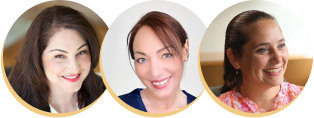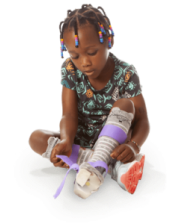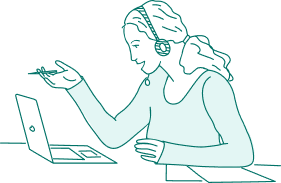Cerebral palsy special education options
Educational services and support for children with cerebral palsy (CP) must begin as early as toddlerhood to allow for the proper development of important life skills.
The Individuals with Disabilities Education Act (IDEA) of 2004 guarantees the right of all children with disabilities between the ages of 3 and 21 to a Free Appropriate Public Education (FAPE).
FAPE ensures that children with disabilities receive appropriate instruction based on their unique needs. This provides children access to education in the general classroom and the ability to develop self-sufficiency and social skills.
The 4 general types of education available for children with disabilities are:
- Public school
- Private school
- Homeschool
- Tutoring
Factors such as learning disabilities, limited mobility, and the family's financial situation must be considered when determining which program best fits a child with CP.
Download your free guide now to learn more about all aspects of life with CP, including cerebral palsy special education options.
Public school for cerebral palsy students
Public schools are the largest provider of general and special education services. They offer many benefits for children with all types of cerebral palsy.
Public school is a good choice for families who want a free education for their child. Public school provides a chance for children to learn and socialize with their peers, which helps prepare them for independence and develop social skills.
A notable disadvantage to choosing public school for cerebral palsy special education is the unreliability of services across school districts. If the child changes locations or transfers schools, they may fall behind if the curriculum or disability accommodations offered aren't the same.
Also, there tends to be a lack of information made readily available to parents about the services provided by cerebral palsy support organizations. This can result in a less-than-ideal educational environment for a child with CP.
- Full inclusion
- Special education or self-contained classrooms
You can choose one type of inclusion or a combination of both depending on your child’s individualized education plan (IEP).
Full inclusion in public schools
Some parents feel their children should be mainstreamed within the education system as early and often as possible. This allows the students to be in an environment where classmates exhibit age-appropriate behaviors and learn from each other.
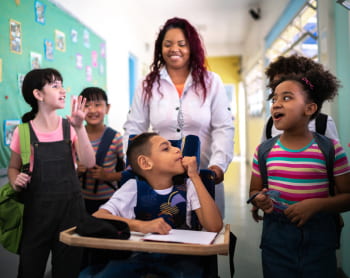 Full inclusion allows all children to participate in a standard classroom setting. A child with cerebral palsy would be accompanied by a teacher's aide instead of being removed from the classroom and excluded from the group. Children would still have access to self-contained classrooms, one-on-one help, and other cerebral palsy special education resources for specific lessons or testing.
Full inclusion allows all children to participate in a standard classroom setting. A child with cerebral palsy would be accompanied by a teacher's aide instead of being removed from the classroom and excluded from the group. Children would still have access to self-contained classrooms, one-on-one help, and other cerebral palsy special education resources for specific lessons or testing.
However, a major disadvantage to full inclusion within a public school is that students with CP may not receive the help or attention they need.
Additionally, this may not be the best option if a child is dealing with a severe physical or intellectual mental disability, as they could become overwhelmed or disruptive in a typical classroom setting.
Special education or self-contained classrooms
If it is decided that full inclusion is not the best option, the child can be placed in a cerebral palsy special education or self-contained classroom program. This type of schooling is available to students who meet the IDEA’s criteria.
- Autism
- Deaf-blindness
- Deafness
- Emotional disturbance
- Hearing impairment
- Intellectual disability
- Multiple disabilities
- Orthopedic impairment
- Specific learning disability
- Speech or language impairment
- Traumatic brain injury
- Visual impairment (including blindness)
- Other health impairments
While cerebral palsy is not listed explicitly under these qualifications, a child with CP can qualify under various categories that would allow them to enroll in cerebral palsy special education programs or self-contained classrooms.
Private school for cerebral palsy students
Private school for a child with a disability can be an excellent option for those with specific needs or restrictions that would directly impact their education.
The two general types of private schools are:
- Conventional private schools
- Special education centers
Both types of schooling present advantages and disadvantages for a child with CP that should be considered.
Understanding the severity of your child’s condition can play a huge role in determining what cerebral palsy education resources your child may need.
If you have questions about your child’s cerebral palsy that may help you gauge how severe their condition is, connect with one of our registered nurses now.
Conventional private school for cerebral palsy students
Enrolling a child with cerebral palsy in a private school can offer several benefits. Many private schools offer the opportunity to receive religious instruction. This can be a great option for families who value incorporating faith into education.
Another advantage of a conventional private school is that the classrooms typically have smaller student-to-teacher ratios. This can benefit a child who requires additional attention and support since they will typically receive more personalized attention.
A private school can provide a supportive environment for children with cerebral palsy to thrive academically and socially. However, some private schools have admissions processes and may decide they cannot meet your child’s needs. Additionally, private schools can be expensive and may not fit your family’s budget.
If your child’s condition was caused by a medical mistake, you may be able to access critical funds to help pay for cerebral palsy special education. Connect with us today for a free consultation.
Special education centers
There are various education centers devoted to children with physical impairments, like CP.
These education centers typically have specialized equipment, technology, and coursework, and special education teachers who are trained to educate students based on each child's abilities.
One disadvantage of this form of private education is that it can be costly. However, scholarships are available for low-income or at-risk families that need financial assistance.
Options for homeschooling
Parents who decide to provide cerebral palsy special education at home should be ready for immense devotion, patience, and care. If the proper attention is given, homeschooling can be a highly beneficial method for educating children with cerebral palsy.
The flexibility of homeschooling also makes it easier to incorporate other treatments into the school day, such as physical and occupational therapy.
Homeschooling is also beneficial if a child has a short attention span, unpredictable sleeping patterns, or uses mobility aids. Since these factors can negatively impact a child's performance in a typical classroom, being educated at home may alleviate these pressures.
With parents taking on the duty to educate their child, they need the proper resources and teaching materials to ensure that the child receives a high-quality education. Parents can acquire these resources from several sources, from their public library to state and national homeschooling organizations. These groups also offer field trips, meet-ups, music classes, art classes, and other activities to ensure children get to socialize with each other.
Options for private tutoring
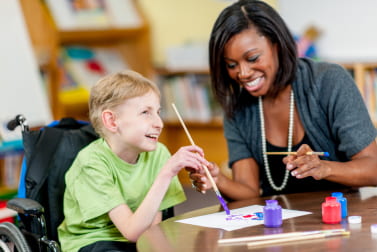 Private tutoring is a great way to supplement a current educational program. This can be an excellent option if a child with CP struggles to grasp a specific subject or needs one-on-one attention.
Private tutoring is a great way to supplement a current educational program. This can be an excellent option if a child with CP struggles to grasp a specific subject or needs one-on-one attention.
Tutoring can help improve study habits and help children stay on track. Individual tutoring sessions are great for parents looking for a cost-effective way to enhance their child's cerebral palsy special education without having to pay for private schooling.
Cerebral palsy education resources
Parents and teachers alike can benefit from cerebral palsy education resources. These materials, programs, and services are specially designed to support the educational requirements for people living with CP.
Reading is one of the top educational provisions for cerebral palsy students. However, many people with CP have print disabilities, making reading challenging. Bookshare® is an online library of reading materials that can be accessed using assistive technology tools. Memberships can be obtained through schools, organizations, or for at-home use.
Here are some additional cerebral palsy special education tips for parents and teachers.
Cerebral palsy special education tips for parents
Parents of children with CP face unique issues and concerns, from navigating the special education system to advocating for their child's needs in the classroom.
Fortunately, many resources are available to help parents support their child's education and ensure they receive the services and accommodations they need to thrive.
- Advocate for all aspects of your child’s development
- Ask for help from friends and family
- Attend meetings and participate in decision-making
- Establish open communication and collaborative relationships with your child's teachers and other staff within their school system
- Familiarize yourself with the IDEA, other disabilities acts, and any accommodations and services your child is entitled to according to applicable special education laws
- Keep all paperwork related to your child's education — including assessments, evaluations, and IEP — organized and easily accessible
- Learn from teachers, paraprofessionals (uncertified teachers who provide assistance to students in the classroom), and other parents
- Stay up-to-date on new assistive technologies
Above all, be patient and stay positive. Showing love and playing with your child is perhaps one of the best tips you’ll ever receive.
Cerebral palsy special education tips for teachers
Educating children with CP requires knowledge, creativity, and flexibility. By understanding each student's unique needs and working openly with their parents and other professionals, you can provide each student with the opportunity to succeed.
Here are some additional tips for providing cerebral palsy special education:
- Adapt your teaching methods and materials to meet the unique learning needs of your student with cerebral palsy
- Educate yourself about CP and how it affects each of the students in your classroom
- Foster an inclusive classroom environment where all students feel valued and no one feels left out
- Incorporate opportunities for movement and physical activity to help your student with cerebral palsy stay engaged and alert
- Learn about the specific accommodations and services each of your students requires
- Make necessary modifications to the physical environment, such as providing assistive technology, accessible seating, or adaptive equipment, to ensure your student has full access to the curriculum
One of the most important things you can do to provide effective cerebral palsy education is to be patient and flexible.
It is critical to accept that it may take longer for your student with CP to complete certain tasks or activities. Adopting an attitude of acceptance and patience will allow you to be prepared to modify your teaching approach as needed.
5 helpful cerebral palsy organizations
Finding high-quality resources dedicated to families with cerebral palsy and other special needs is often the best way to begin your search for cerebral palsy special education options.
Here are 5 nonprofit organizations you can reach out to for assistance:
- United Cerebral Palsy (UCP): This is one of the largest national health nonprofits supporting individuals with CP and other disabilities. It provides resources to secure assistive technology, understand laws, locate caregiving options, and access ongoing support.
- Cerebral Palsy Foundation (CPF): This organization is made up of a network of experts and prestigious medical institutions that help advance cerebral palsy treatment and access to critical information about this condition.
- March of Dimes: Founded in 1938, this organization works to improve the health of mothers and babies by funding research, advocating for policies, and providing education and support to families.
- The Arc: This organization was founded by parents of children with intellectual and developmental disabilities in 1950 to support and advocate for other families seeking services and support for their loved ones.
- Easterseals: This national organization, founded in 1919, has local affiliates that offer services and programs to people with disabilities.
What are the best schools for a child with cerebral palsy near me?
Choosing a school is a very personal decision that should be made with your child’s unique situation in mind.
One of the best places to begin is to talk with your child’s pediatrician about what may work best based on the severity of their condition.
Additionally, you can connect with your state’s local UCP office to get their suggestions.
Once you have recommendations on schools that could be a good fit for your family, develop a standard set of questions. By asking the same questions, you can compare how each option measures against the others.
- Does your facility have a budget to accommodate children with special needs?
- What academic options do you have for children with cerebral palsy?
- What accommodations do you offer for children with special needs?
- What mobility-accessible options does your facility offer?
- Will my child be in a separate classroom or a full inclusion program?
Finding an appropriate school for a child with CP can be difficult, with the search sometimes starting in preschool and continuing through high school and even college.
However, investing time in finding schools that can provide suitable accommodations for your child's specific needs is crucial to ensure they have the opportunity to thrive and reach their full potential.

